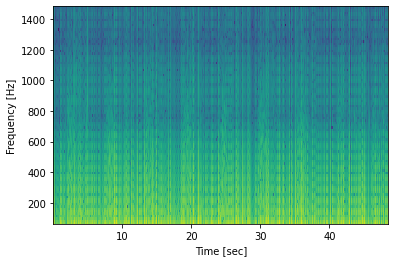This was a short 'hackathon' style project for the UKRI UCL Centre for Doctoral Training in AI-enabled Healthcare Systems end of year symposium 2021.
👩💻 Team: Chris Tomlinson, Joe Farrington, Vicky Smith
🎯 Task: Free reign to envisage/prototype an AI-enabled solution to data captured from a digital stethoscope 🩺📈
🌆 Commercial partner: Start-up operating in 'stealth mode' 🕵️♂️
⏰ Time scale: ~2 hours before delivering a 10 minute presentation 👨🏫
We constructed a Random Forest Classifier able to predict periods of inspiration (breathing in) from a .wav file from a digital stethoscope.
- We used
librosato import the.wavfile, produce a spectrogram and store this as a numpy array - We applied a High Pass Filter at 50 Hz and a Low Pass Filter at 1.5 kHz by cropping the numpy array to focus on the frequencies of interest, producing a feature matrix
X
- An outcome vector
ywas created by manually listening to the.wavfile and noting timestamps at which inspiration began and ended. These were then converted to a vector, of lengthX, wherey=1during inspiration, elsey=0 - We partitioned the
.wavfile into ~80/20% train/test split, manually adjusting the breakpoint to leave two complete breaths for test evaluation - We trained a
RandomForestClassifier()andXGBClassifier()using thesklearnpackage. We selected these algorithms for their well-documented high-performance - Evaluation on the held-out test set gave an
AUC = 0.84for the Random Forest classifier, as seen on the ROC curve below
- Despite achieving a remarkably good performance out-of-the-box it's important to note this model was trained and evaluated on the same
.wavfile (and patient), which does not a represent a real-world scenario - Further work could involve:
- Hyperparameter optimisation
- Utilising additional data, from multiple patients, for both testing and training
- Use of a 'sliding-window' style approach and exploring deep learning solutions
Overall this was a really enjoyable morning. Having never taken part in a 'hackathon' or worked in the tech industry it was great a taste for the excitement and creativity that a sprint-style of working can bring, not to mention that after a year of COVID-19 enforced remote learning, collaborating with, and learning from, colleagues was a particular highlight!
Many thanks to the CDT team: Prof Paul Taylor, Dr Ken Li and Craig Smith, for their hard work in organising the event, as well as the commercial sponsors for their time, ideas and mentorship.
I look forward to next year!

